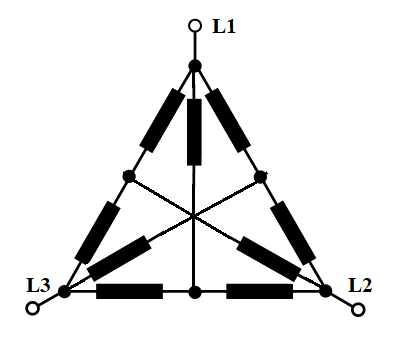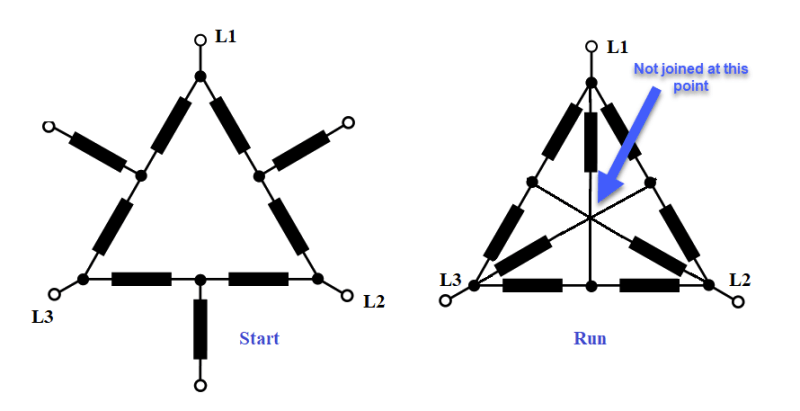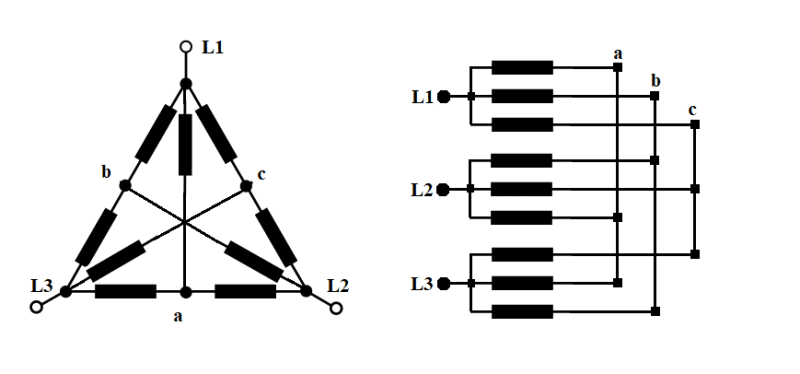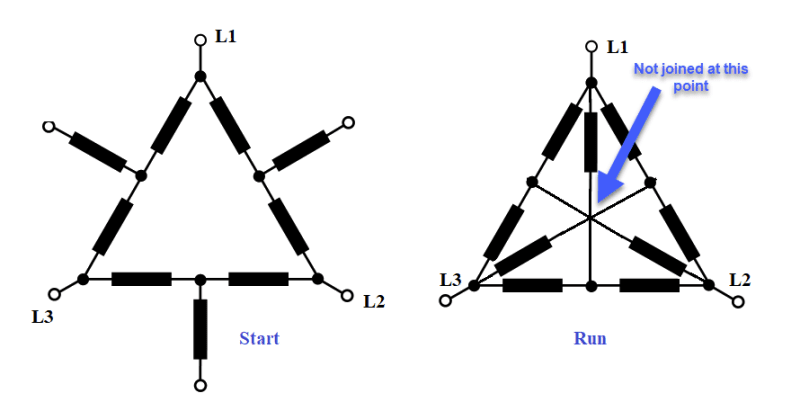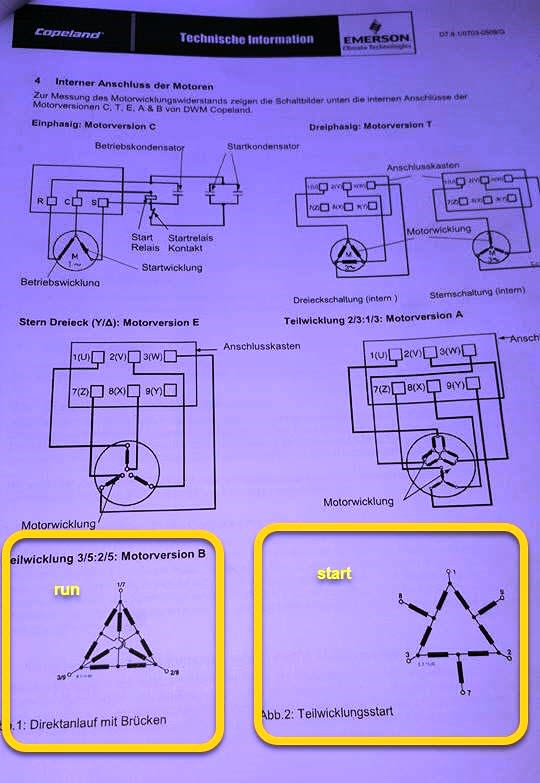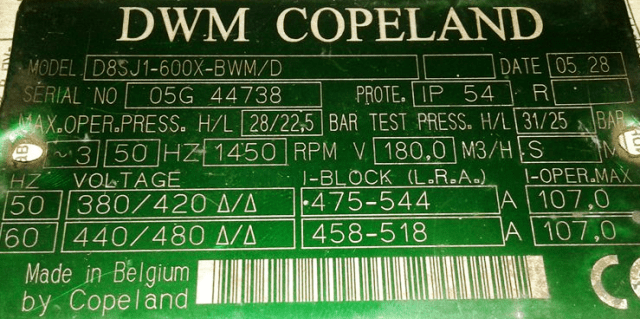Navigation
Install the app
How to install the app on iOS
Follow along with the video below to see how to install our site as a web app on your home screen.
Note: This feature may not be available in some browsers.
More options
Style variation
-
Congratulations MintJulep on being selected by the Eng-Tips community for having the most helpful posts in the forums last week. Way to Go!
You are using an out of date browser. It may not display this or other websites correctly.
You should upgrade or use an alternative browser.
You should upgrade or use an alternative browser.
Unknown motor connection
- Thread starter EngRepair
- Start date
- Status
- Not open for further replies.
- Thread starter
- #3
- Moderator
- #4
You are showing windings that probably don't exist.
It is probably a consequent pole connection or Dallander connection.
Motors with six individual windings are common in both IEC land and NEMA land.
There are no common motors with nine windings.
Bill
--------------------
"Why not the best?"
Jimmy Carter
It is probably a consequent pole connection or Dallander connection.
Motors with six individual windings are common in both IEC land and NEMA land.
There are no common motors with nine windings.
Bill
--------------------
"Why not the best?"
Jimmy Carter
- Thread starter
- #5
The first image shows three discrete star windings, as does the re-drawn one in the final image. There's no connection at the star point, to a neutral or to another winding's star point. The behaviour of the motor will depend on the physical displacement between the windings.
- Moderator
- #8
120/208 Volt supply?
Delta start with 104 across two windings?
Star run with 120 Volts across three windings?
Rather than a star/delta start, a part winding, delta/star start?
Is this a refrigeration set or an air conditioning set?
Can you give us a specific make and model?
Bill
--------------------
"Why not the best?"
Jimmy Carter
Delta start with 104 across two windings?
Star run with 120 Volts across three windings?
Rather than a star/delta start, a part winding, delta/star start?
Is this a refrigeration set or an air conditioning set?
Can you give us a specific make and model?
Bill
--------------------
"Why not the best?"
Jimmy Carter
- Moderator
- #9
Here is the delta start connection: A series delta for 50% line to line voltage across each winding rather than the familiar straight delta with 100% of line to line voltage across each winding.
Wow. Over 50 years wandering from the Yukon Territory (Beside Alaska but often colder) to the Bay Islands and theMoskito Miskito Coast and there is still something new.
Bill
--------------------
"Why not the best?"
Jimmy Carter
Sorry for being slow to get my head around this one, EngRepair.
Wow. Over 50 years wandering from the Yukon Territory (Beside Alaska but often colder) to the Bay Islands and the
Bill
--------------------
"Why not the best?"
Jimmy Carter
LionelHutz
Electrical
During running, each winding sees 57.7% of the line-line voltage.
During starting, 6 of the 9 windings see 50.0% of the line-line voltage. 1 winding from each phase is not connected.
It's a strange connection. Possibly done to make the contactor used to switch the motor to it's running connection smaller compared to other starting methods. Also eliminates the need for any contactor interlocking.
During starting, 6 of the 9 windings see 50.0% of the line-line voltage. 1 winding from each phase is not connected.
It's a strange connection. Possibly done to make the contactor used to switch the motor to it's running connection smaller compared to other starting methods. Also eliminates the need for any contactor interlocking.
- Thread starter
- #11
- Moderator
- #12
For discussion Lionel;
Star delta, The starting voltage = 57.7% Starting torque = 33%
This arrangement, The starting voltage is 50%/57.7% = 86% Starting torque = 75% Time two windings out of three = 50% torque.
Will this give better starting torque than a conventional star/delta start?
Does this agree with your figures?
Bill
--------------------
"Why not the best?"
Jimmy Carter
Star delta, The starting voltage = 57.7% Starting torque = 33%
This arrangement, The starting voltage is 50%/57.7% = 86% Starting torque = 75% Time two windings out of three = 50% torque.
Will this give better starting torque than a conventional star/delta start?
Does this agree with your figures?
Bill
--------------------
"Why not the best?"
Jimmy Carter
- Moderator
- #13
This connection is interesting as it uses a series delta connection. And parallel star connections.
If my calculations are correct, The 50% of locked rotor torque should be enough to come up to speed.
A conventional star/delta start with 33% of locked rotor torque may stall or not come up to speed on a compressor.
I am familiar with the Copeland marke. I have worked on a lot of Copelands. All were DOL start.
Thank you for the new information.
Bill
Bill
--------------------
"Why not the best?"
Jimmy Carter
If my calculations are correct, The 50% of locked rotor torque should be enough to come up to speed.
A conventional star/delta start with 33% of locked rotor torque may stall or not come up to speed on a compressor.
I am familiar with the Copeland marke. I have worked on a lot of Copelands. All were DOL start.
Thank you for the new information.
Bill
Bill
--------------------
"Why not the best?"
Jimmy Carter
- Moderator
- #14
Another interesting point.
The starting connection is similar to a consequent pole or Dallander connection.
While the run synchronous speed is 1500 RPM, the starting synchronous speed may be 750 RPM.
Comments?
Bill
--------------------
"Why not the best?"
Jimmy Carter
The starting connection is similar to a consequent pole or Dallander connection.
While the run synchronous speed is 1500 RPM, the starting synchronous speed may be 750 RPM.
Comments?
Bill
--------------------
"Why not the best?"
Jimmy Carter
I am with EngRepair
This is a 1/3th-2/3th Part Winding start connection. It is a three-layer winding where the firs layer is connected in one star and two layers remaining are paralleled and connected in 2-Y. The first layer has i.e X # Turns and Y # wire size and the second and third layers has 2 X # Turns and 2 Y wire size.
Regards
Petronila
This is a 1/3th-2/3th Part Winding start connection. It is a three-layer winding where the firs layer is connected in one star and two layers remaining are paralleled and connected in 2-Y. The first layer has i.e X # Turns and Y # wire size and the second and third layers has 2 X # Turns and 2 Y wire size.
Regards
Petronila
- Status
- Not open for further replies.
Similar threads
- Replies
- 2
- Views
- 7K
- Locked
- Question
- Replies
- 25
- Views
- 3K
- Question
- Replies
- 6
- Views
- 9K
- Locked
- Question
- Replies
- 1
- Views
- 2K
- Replies
- 5
- Views
- 10K

